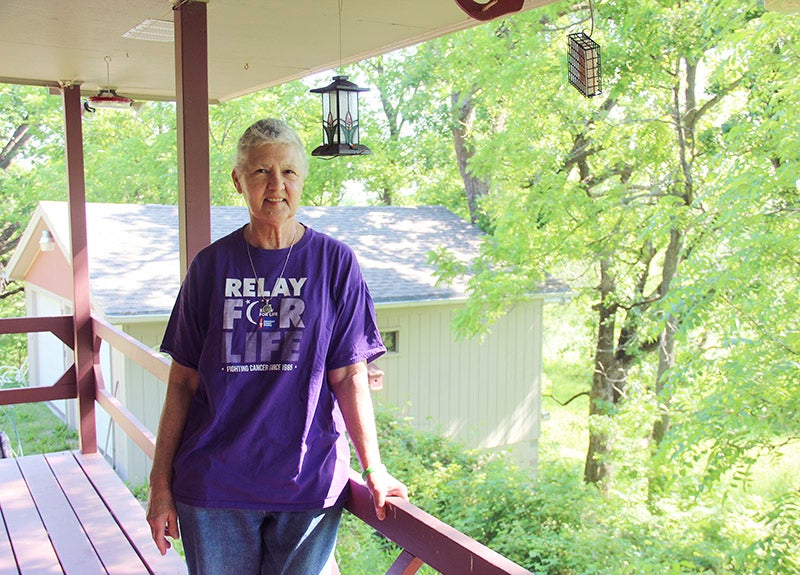Researchers search for clues to toxic algae blooms in Minnesota
Published 10:12 pm Friday, August 18, 2017

- When lake temperatures warm, blue-green algae thrives, often forming in thick, pea-soup colored blooms that spread out across the surface of lakes. - Dan Kraker/MPR News
By Dan Kraker, Minnesota Public Radio News
From Washington Lake in southwest Minnesota, to Lake Minnetonka, to Helen Lake in northern Minnesota, toxic blooms of algae are again surfacing on the state’s lakes.
They’re suspected culprits in one case of human illness and two dog deaths so far this summer.
When lake temperatures warm, blue-green algae thrives, often forming in thick, pea-soup colored blooms that spread out across the surface of lakes.
The algae has been present in Minnesota since at least the turn of the 19th century. But it’s only recently exploded on the public’s radar. It’s believed to have killed 20 dogs in Minnesota since 2004, including this August at Lake Minnetonka and at Lake Geneva, near Alexandria.
No human deaths have been attributed to it in Minnesota, but there have been reports of people sickened by it, including earlier this year on Helen Lake in Itasca County.
In 2014, Toledo, Ohio, had to stop pumping drinking water from Lake Erie for two days because blooms had poisoned the water.
Now researchers are fanning out across Minnesota, trying to figure out what exactly triggers the blooms, and what lakes might be at most risk.
Peltier Lake is small and scenic, tucked between Interstates 35E and 35W in the Lino Lakes area. It’s home to a large population of great blue herons and other big birds. But it’s also often home to toxic algae blooms.
“See how that little glob there is almost like green paint? That’s nasty stuff,” said Andy Bramburger, a researcher at the University of Minnesota Duluth’s Natural Resources Research Institute, as he steered his boat into a shallow bay. “It almost looks like an oily sheen,” he said, pointing at turquoise colored, shiny scum floating on the water’s surface, that had a distinctive metallic smell to it.
It’s often called blue-green algae. Scientists often call them harmful algal blooms, but in reality, it’s not algae at all. It’s something called cyanobacteria.
Bramburger is trying to zero in on the conditions that cause the harmful algae, or cyanobacteria, to form. He uses a special bottle to collect water samples from seven sites around Peltier Lake.
It’s one of six lakes around the state he’s surveying. The goal is to identify variables in the water that can help predict when harmful algae blooms occur, factors like nutrients, dissolved oxygen and temperature.

University of Minnesota-Duluth graduate researcher Matt Bambach points at an algae bloom on Peltier Lake, which is actually not algae at all. It’s something called cyanobacteria. – Dan Kraker/MPR News
Researchers have known for a long time that pollution from phosphorous and nitrogen increases the likelihood for harmful algal blooms to form. But Bramburger said he’s found that blooms can be just as bad in suburban lakes as in lakes surrounded by farm fields.
“It is easy to blame farmers for putting nutrients into the fields, but I think a lot of residential pesticide and fertilizer use on lawns, and pet waste, can also be big contributors to nutrient problems in inland lakes,” he said.
Scientists at the University of Minnesota and the Science Museum of Minnesota’s St. Croix watershed research station are collecting similar data at other lakes around the state.
A key mystery Science Museum associate scientist Adam Heathcote is trying to unravel is why some algae blooms become toxic, but not all of them.
“We’ve known for long time that nutrient pollution increases the chance for harmful algal blooms,” he said. “What we’re specifically looking at is what causes those blooms to switch from nuisance situations to toxic situations that are harmful to wildlife, pets and humans.”
There is evidence of harmful algae blooms in southwestern Minnesota dating back to the late 1800s, when livestock deaths there were attributed to green, slimy water.
But it wasn’t until 2004 that the Minnesota Pollution Control Agency started getting phone calls about it. Now, anecdotal reports of blooms are on the rise, especially in hot years, like 2009, and 2015.
Still, researchers don’t have hard data to show an actual increase in blooms.
So they’re also drilling sediment cores from the lake bottoms, sampling to look back in time 250 years to see past incidences of algae blooms.
They’re also starting to deploy monitoring equipment and even cellphone apps, through which people can submit photos of blooms to accumulate a broad swath of data showing exactly when and where algae blooms are forming.
Much of the research is already pointing to a similar conclusion: Minnesota will see more intense, more frequent harmful algae blooms in the future.
Chris Filstrup, a lake scientist with the Minnesota Sea Grant and the Large Lakes Observatory at the University of Minnesota Duluth, said a changing climate is creating the perfect stew of conditions for harmful algae to thrive.
Warmer water creates bigger temperature differences between the water at the surface of the lake, and deeper water, he explained.
That favors the blue-green algae, or cyanobacteria, because over billions of years they’ve evolved a way to regulate their buoyancy. So they can float to the warm water at the surface and out-compete other algae for sunlight.
On top of that, the more frequent and intense storms Minnesotans have experienced in recent years wash more nutrients into lakes, which feeds the cyanobacteria.
“Then if that period is followed by a really hot intense drought period, you’re basically putting all the ingredients you need for cyanobacteria blooms into the pot, and then you’re heating up that lake, to favor cyanobacteria,” Filstrup said.
As researchers hone in on what specifically triggers the formation of those toxic blooms, the hope is to identify the conditions to avoid in lakes in the first place, and also to be able to warn the public when those lakes are dangerous for people or pets.
In the meantime, Pam Anderson with the Minnesota Pollution Control Agency has a simple message:
“If you’re in doubt, get out or keep out. If the water looks questionable, and you’re not sure whether you should be in it, just don’t go in the water.”





